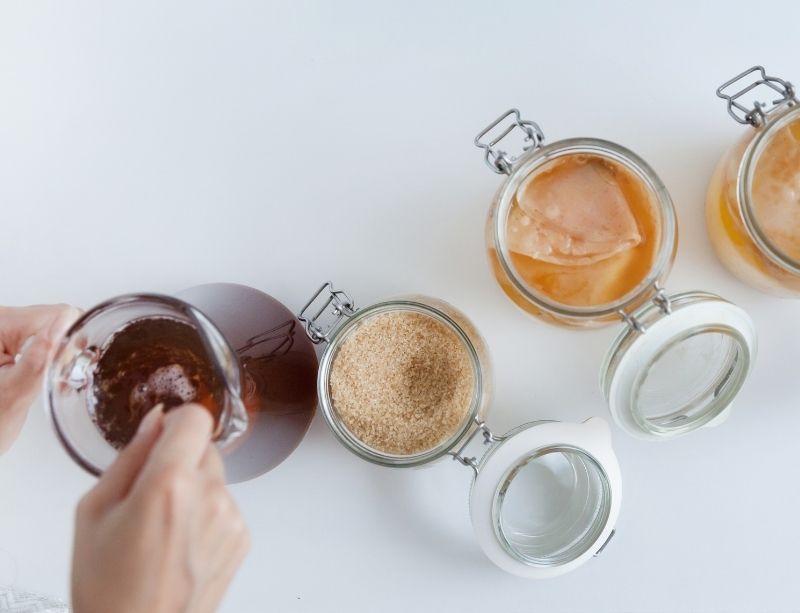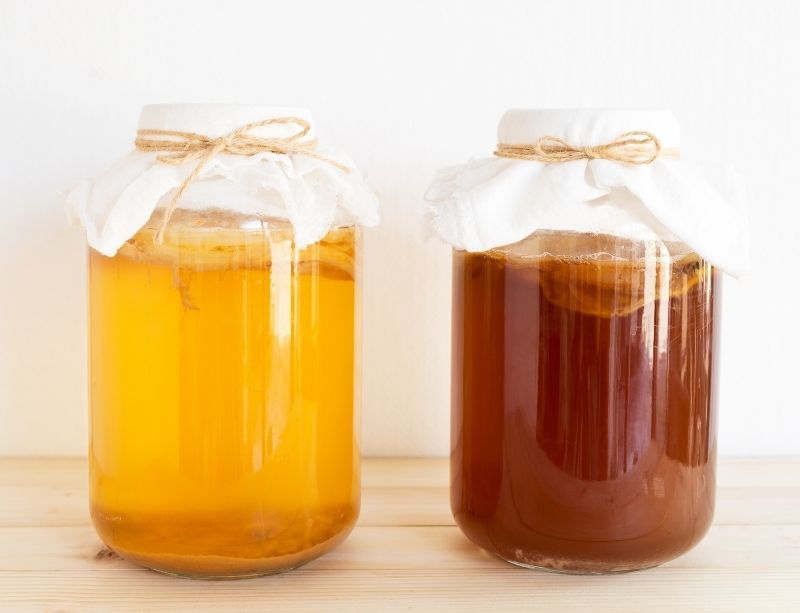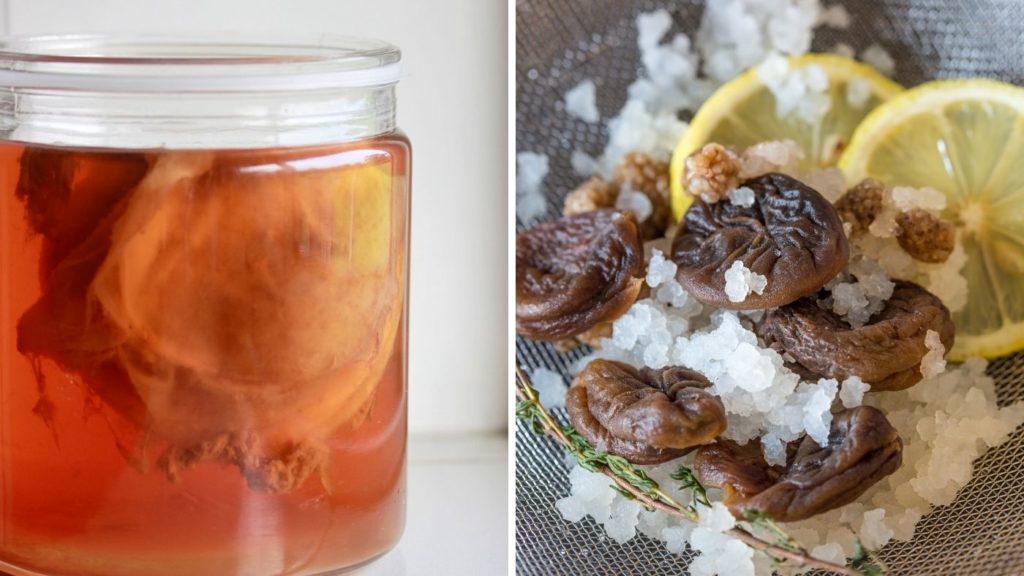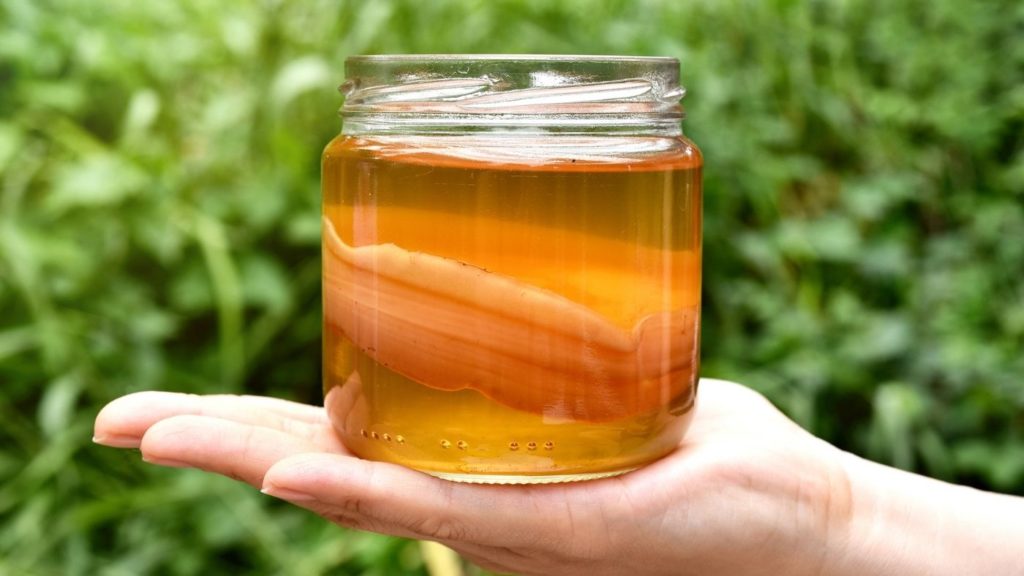You have started brewing homemade kombucha, and you are wondering how much alcohol is in your kombucha. The answer is here!
And if you want to control the alcohol content (whether high or low, as in our boozy kombucha recipe), there are a few things you should know.
Go directly to the section that interests you:
- Why does kombucha contain alcohol?
- Factors influencing the alcohol content
- How to make a low alcohol kombucha
- How to make a high alcohol kombucha
How Much Alcohol Is in Homemade Kombucha?
Homemade kombucha contains a low level of alcohol. In general, the alcohol content of homemade kombucha is between 1% and 2.5%.
Commercial kombucha, on the other hand, has an alcohol percentage of less than 0.5%. It is indeed sold as a non-alcoholic beverage and therefore must not exceed this limit to be considered non-alcoholic in many countries.
Why Does Kombucha Contain Alcohol?
Alcohol is a natural by-product of kombucha fermentation.
Fermentation occurs through the action of bacteria and yeast contained in the kombucha scoby. In this process, yeast eat the sugar found in sweetened tea. As they digest it, they produce CO2 as well as alcohol. Once the alcohol is produced by the yeast, the bacteria begin to transform it into acetic acid. In other words, vinegar!
It is through these processes that kombucha becomes a naturally low sugar, but slightly alcoholic and vinegary drink.
Unfortunately, it is difficult to know the exact alcohol content of each batch. Only very expensive and complex equipment can provide such a measurement. The hydrometer, generally used to measure the alcohol content of a liquid, will not be able to give an exact reading because of the large number of particles in suspension.

Factors Influencing the Alcohol Content of Kombucha
1. Sugar Content
Since alcohol is produced by yeast eating sugar, the initial amount of sugar will determine how much alcohol the yeast could potentially produce.
The more sugar there is to start with, the higher the alcohol content of the kombucha.
But beware, there is a limit to how much sugar can be fermented by the yeast! There is no way to turn your kombucha into whisky.
When making wine, beer, or cider, adding sugar usually increases the alcohol content.
In kombucha, which is a mixed fermentation, the presence of bacteria will reduce the final amount of alcohol as they feed on it to produce vinegar.
2. The Yeast Present
Kombucha fermentation is a wild fermentation, affected by quality, quantity, and types of active yeast present in the kombucha culture (the starter).
The richer the yeast culture, the higher the alcohol content of the kombucha. However, there are thousands of different types of yeast with different characteristics.
Their number and strength will influence the final alcohol content of the kombucha, but the brewer has little influence on this factor.
Kombucha is an open-air fermentation. This means that there will be an exchange of microorganisms between the kombucha and its environment.
Wild yeast will vary from one environment to another. It is therefore impossible to predict which ones will colonize our kombucha, and how they will influence the alcohol content of our fermented tea!
3. Fermentation Temperature
The ambient temperature of the room in which the kombucha is fermented will determine the alcohol level of the final product.
Yeast in kombucha, which are responsible for producing alcohol, are more active at warmer temperatures.
They will consume more sugar and produce more alcohol when the fermentation temperature is higher.
Incidentally, the bacteria in kombucha prefer cooler temperatures!
This is how you can manipulate the alcohol level, but also the acidity level of your kombucha.
Fermenting at a higher temperature will produce a more alcoholic kombucha, while fermenting at a lower temperature will produce a more acidic kombucha!
4. Fermentation Time
At the beginning of the kombucha fermentation process, yeast multiply rapidly and produce a large amount of alcohol and carbon dioxide.
This step lasts about a week. After this initial phase, fermentation slows down, and the amount of alcohol produced by the yeast decreases.
At this point, the bacteria become more active and use alcohol and oxygen to convert them into acetic acid.
Kombucha then begins to develop a tangy taste, and its alcohol level begins to drop.
Kombucha that has been fermented for a longer period of time, therefore, contains less alcohol than a young kombucha.
5. The Surface in Contact With Air
Acetic bacteria need oxygen to convert the alcohol in kombucha into vinegar.
The more contact the kombucha has with air, the more its alcohol content can be lowered because it will have been transformed into acetic acid.
A container with a wide opening will allow better air exchange than one with a narrow one. It will therefore have less alcohol.
Similarly, a kombucha fermenting in a well-ventilated room will have a better air exchange than a kombucha fermenting in a wardrobe.
The greater the air exchange, the lower the amount of alcohol.

How to Make a Low Alcohol Kombucha?
It is possible to brew a homemade kombucha with very low alcohol content.
To reduce kombucha alcohol content, you can:
- Limit the amount of added sugar to 50g (¼ cup) per litre
- Keep the fermentation temperature at 20 to 28°C
- Extend the fermentation time from 10 to 15 days
- Do not add sweet ingredients at the time of flavouring
- Limit fermentation time in the bottle before placing it in the fridge
A more radical solution is to produce a sugar-free kombucha!
The idea is not to eliminate the initially added sugar (that wouldn’t work), but to let it ferment for a very long time. For more information, see our recipe for sugar-free and alcohol-free kombucha or our kombucha vinegar recipe.
How to Make a High Alcohol Kombucha?
To produce a high alcohol kombucha, you need to create an environment in which yeast can grow quickly and acetic acid bacteria activity is limited.
To increase the alcohol content of kombucha, one can:
- Increase the level of added sugar to 100g (½ cup) per litre
- Maintain a fermentation temperature between 28 and 35°C
- Reduce the fermentation time from 7 to 10 days
- Add sweet ingredients at the time of flavouring
- Keep the bottles at a temperature between 25 and 35°C before putting them in the fridge
For a simple and very effective method, see our hard kombucha recipe.
Another technique that does not require temperature control is to limit the presence of oxygen.
To do this easily, you can:
- Ferment your kombucha for 5 days in your usual container
- Empty the liquid (without the mother) into a carboy for a few more days.
Thanks to its narrow neck and airlock, the carboy will limit the presence of oxygen. Bacteria will no longer be able to transform the alcohol into acetic acid.

